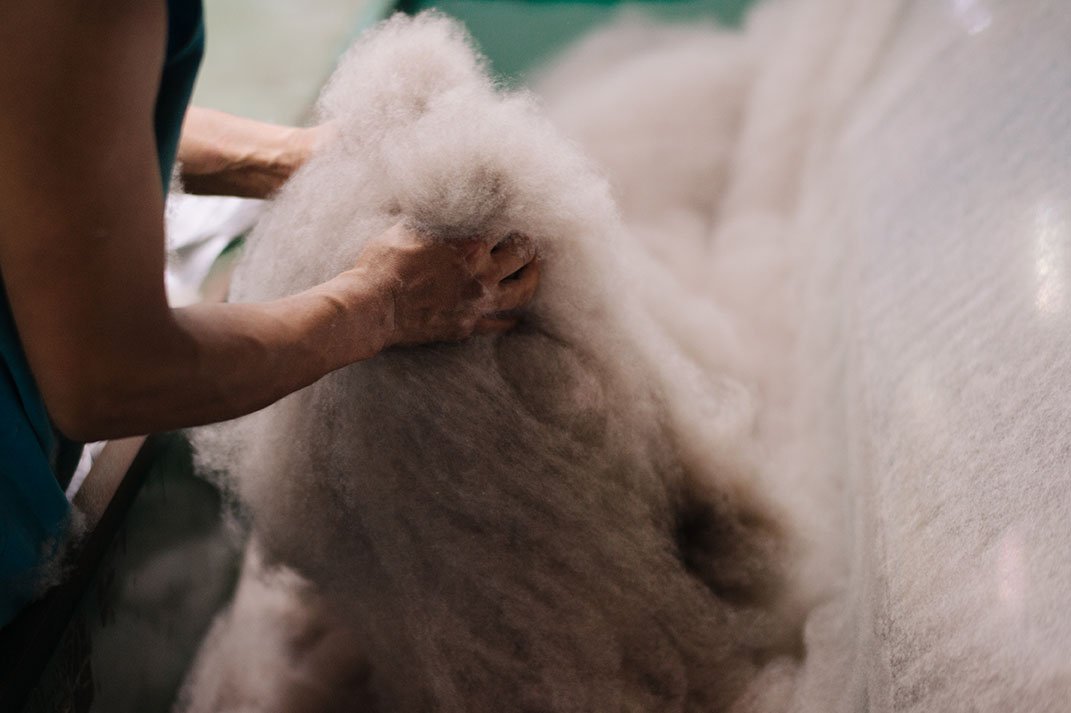Oyuna: The Art of Narrowing Down
Words by Anna Roos van Wijngaarden, photography by Dominic Nitsche
Nomadic herders in Mongolia take care of their cashmere goats in harsh winters and hot summers. Goats moult once a year, and it takes 3–4 goats to produce enough fibre for one cashmere jumper.
The marriage of less and more has been celebrated for generations, emanating from the tiny yet life-transforming invention of the paperclip to the Pareto Principle and the “Arte Povera” movement. Its essence is seized by the verses of Emily Dickinson, the Wassily Chair, and the introspective journey of Vipassana. The ethos of “less is more” persists in fashion, urging for focused efforts in an industry on the brink of change.
The fashion industry isn’t moving fast enough to meet its climate vows of the Paris Agreement for 2050. To speed up the transition, established brands keep an eye on young, value-driven labels. Bound by resource constraints, these fully commit to clearly defined elements of sustainability, dedicated to making a small, but visible change – be it at the expense of margin or growth. Classic business metrics point at a concern, but loyal, conscious consumers recognise a story that rings true.
These thoughts crossed our mind, after The Lissome was invited to attend the WHITE show in Milano. Guided by our Values & Guidelines, we scouted 190 stands to pick three labels that illustrate how focus can result in significant impact – the kind that transcends numbers, leaving you with a sense of hope and positivity.
Preserving nomadic livelihoods – OYUNA
Our first appointment is at the booth of nomadic cashmere house, OYUNA. The owner is running late, but assistant and model Ilva Kassner is familiar with Oyuna Tserendorj’s story due to their long-standing collaboration. “I’m still working with her because I love her mission,” she says. “She knows the people that make the cashmere. That’s how it’s supposed to be.” Kassner guides us through the collection – harmonious colours combined with architectural shapes. Textures are soft yet robust, providing the cosy couch feeling you expect from a knit-for-life. Fringes made from leftover scraps from previous seasons and reversible jackets signal a conscious circular design ethos, but the essence of the label lies mainly with the makers: Mongolian nomads, our cashmere custodians.
OYUNA AW24 collection
Mongolia is home to one of the last remaining nomadic cultures in the world. Tserendorj begins: “Besides the installation of solar panels to power the mobile phones and TVs, they live as they lived for centuries: one with nature. They wake up at 4 am to take the livestock out for grazing, make felt from wool for their gers [tents], or milk products, and go to bed early, living in sync with the sunrise. The lifestyle of Mongolian nomadic families is all about what their livestock needs, so they move at least four times a year, dictated by factors such as grass length and access to water sources and sheltered locations, or to allow pastures to regenerate. Their nomadic rhythm is in harmony with the natural cycles of the land.” Tserendorj calls them custodians, “because they are the ones taking care of the cashmere goats 365 days a year, only to comb them once in spring for their cashmere.”
Cashmere goats love being combed once a year when spring comes. After combing, the goats are ready for the hot summer.
OYUNA’s vantage point paints a picture: “We want future generations to have what Mongolians experience today: a vast and free land with no fences, steppes full of aromatic wild herbs, mountains with wildlife and nomads with centuries-old traditions.” Living in London after finishing her clothing engineering degree in Budapest, Tserendorj found herself wanting to reconnect with her Mongolia. OYUNA started as a homeware brand, adding ready-to-wear in 2009. “All along – the same concept of natural cashmere fibre to shine”, says Tserendorj. Born and raised in Ulaanbaatar herself, she talks about the pride ingrained in Mongolian culture, and how climate change and overgrazing threaten the resilience of the land. “Roughly 70% of the soil is altered, with 7% of that being irreversible desertification.”
It’s the people that have led the land to desertify over an incredibly short time span. The number of goats in Mongolia has tripled since 2000. In the Gobi Desert area, the traditional origins of Mongolian cashmere, plants have sturdy long roots and are rich in what Tserendorj calls herbal medicine. Cashmere goats are endemic in these areas. The problem is the grasslands in the north. The pastures in these areas, characterised by plants with shorter roots, are unable to sustain large numbers of grazing goats. Overgrazing, fuelled by fashion’s commercial demand for cashmere, ultimately results in land desertification.
Once delivered to a factory, raw cashmere is hand sorted into four natural colours: White, Cream, Taupe and Beige.
Once washed, raw cashmere gets de-haired, a process where all coarse hair falls off a combing cylinder due to its weight, as pure cashmere underhair is extremely light.
Cashmere can be classified as such from 19 microns, but premium brands often offer a finer quality. OYUNA utilises fibres around 15.6 microns, a desirable quality (Grade A-B) closely linked to traditional practices and know-how. Upon visiting the communities producing for her label year after year, Tserendorj understands that the terms are non-negotiable: “Cashmere needs to remain a special fabric; the fibres need to be used fresh – organic matter loves natural (sun)light and fresh air. They shouldn’t be stored in a dark warehouse to be traded from one hand to another. Therefore, cashmere cannot be cheap.”
Tserendorj found her herding communities through The Sustainable Fibre Alliance (SFA), a non-profit that connects livestock herders to brands and retailers, while addressing challenges to ensure the long-term sustainability of the cashmere sector. Members like OYUNA (certificate) contribute an annual fee to support the mission. In return, they get access to fairer cashmere practices, defined by five principles and publicly disclosed KPIs: decent work (following the ILO standard), biodiversity & land use (from grazing to water resource management), animal welfare, fibre quality improvement and effective management (trainings to improve processes). Tserendorj has found her match: “SFA is doing an amazing job recreating the old traditional ways of pasturing to protect the land, transferring knowledge to the young nomads, studying human impact on the land and how to mitigate its risks, even organising rewards such as ‘female herder of the year’ or ‘best community manager.’”
The freezing Mongolian winters result in very long cashmere fibres, usually between 38–45 mm. The longer the fibre, the softer it is, reducing the likeliness of pilling.
The ambitions are clear, but the road to restoration is long. Cashmere is as intricate as its supply chain. Tserendorj’s assessment distinguishes 99 steps to create a cashmere garment, as depicted in her previous exhibition HANDS. Tserendorj: “Our longstanding customer Andreas Murkudis in Berlin gave us his entire shop for two months to let us showcase the story behind Mongolian cashmere. For this special photo exhibition called HANDS, we went to Mongolia, capturing all the hands involved in the complex process of creating a cashmere garment. It begins with the nomad’s hands caring for the goats, followed by his wife’s hands pouring tea, who manages household tasks and livestock. We document the hands of a truck driver delivering hand-combed cashmere to the factory, then the factory workers’ hands sorting coarse hair from cashmere, hands testing the cashmere microns, and the designer’s hands pattern cutting. The process is enormous. I honestly don’t know how the high street runs the prices of cashmere, because the real costs are much higher than that.”
Dyed or natural coloured, de-haired cashmere is spun into yarn for knitting.
For a woven product, a loom is set up for weaving.
Though SFA is a tool to preserve nomadic cashmere traditions, they don’t verify that all members are actually working with sustainable cashmere themselves. “Our supply chain is very short”, Tserendorj says in response. “Production occurs in the capital, but we know from which areas they collect, as well as the timing of the harvest. We collaborate with two factories, one fully integrated and specialising in home collections. The smaller factory isn’t producing yarn themselves, but they have worked with a single spinner for years. Unfortunately, organic dyes keep giving us subdued colours, so we asked our factories to use high-quality chemical dyes [from Swiss supplier Ciba-Geigy]. Some of our shades are natural [undyed]: beige, taupe, and a rarer ivory white.”
Cashmere yarn is wired onto a knitting machine to knit the garment.
Listening to Tserendorj, we start to understand that in what she calls a “soulful cashmere circle”, everybody wins, allowing for nomadic cultures to thrive again, inspiring the European and American fashion industries with its long-lived craftsmanship, work ethic and spirituality. “The culture I come from is so rich,” says Tserendorj. “Singing, riddles, poetry, storytelling, and music are all deeply ingrained. We even have a special violin, which has only two strings and a horse head at the end. Ceremonies and festivals emphasise family bonds and a profound respect for elders. When you enter the ger, you first greet the owner of the household. The main themes of Mongolian songs are the beauty of the land, horses, mothers, and love. My favourite, “Ode to the Altai Mountains”, immediately transports me to the top of a Mongolian mountain, with its vast, endless views. It’s very emotional for me.”
Ode to the Altai Mountains
There are heavy morning mists
This day is especially cloudy
While ancient it is fertile and plentiful
Vast, in lofty grey, massive and majestic
Oh my Altai of both mountainous and fertile pastures
A ridged mountain range towers beyond Khovd there
Mineral waters pulsate nearby it
There is the quacking of ducks
The cedar forests are exalted here
Their abundant generosity, lovely and plentiful
Oh my Altai of both mountainous and fertile pastures
The snows quickly melt away
There are dispersing flowing waters
Fresh green crops growing here
The cuckoo bird cries alone there
It was truly captivating rich and sweet
Oh my Altai of both mountainous and fertile pastures
Tamarisk mountain ranges tower only there
There are at altitude sallow goats
The Darzai rise beyond, only there
There are red mountain goats clashing
Indeed there is an intriguing beauty
Oh my Altai of mountainous and fertile pastures
This article is the first of a three-part series, The Art of Narrowing Down, conducted after The Lissome was invited to attend the WHITE show in Milan in February 2024.
Visit OYUNA on @oyunalondon and www.oyuna.com for more inspiration.
Anna Roos Van Wijngaarden is an Amsterdam-based freelance journalist, specialised in fashion/textiles, sustainability and business.











